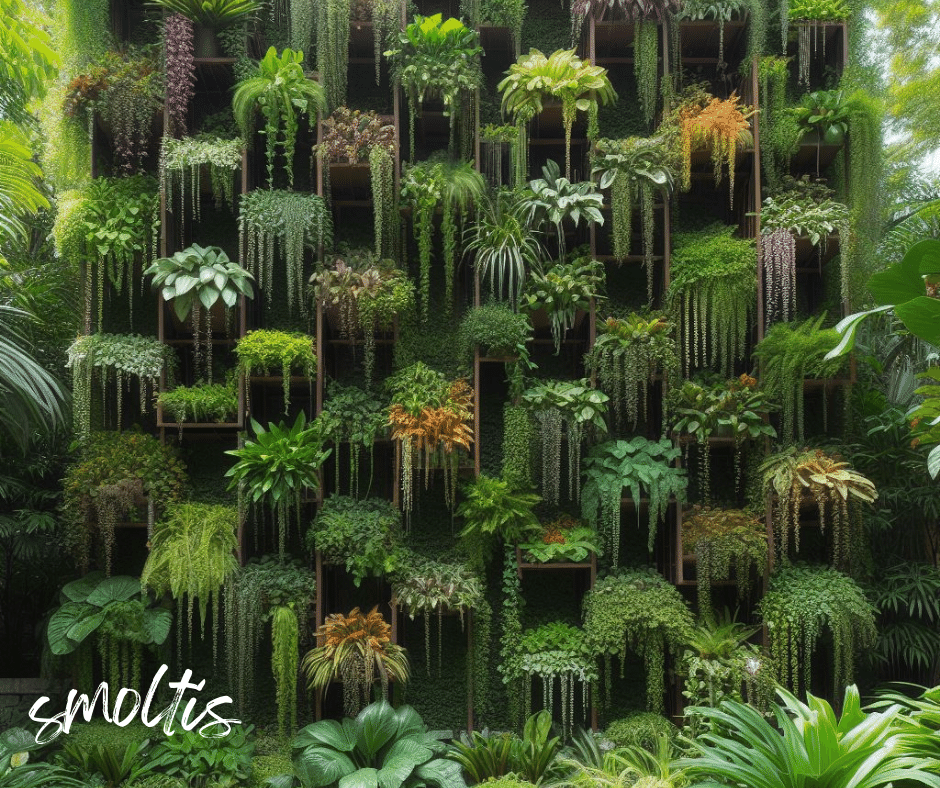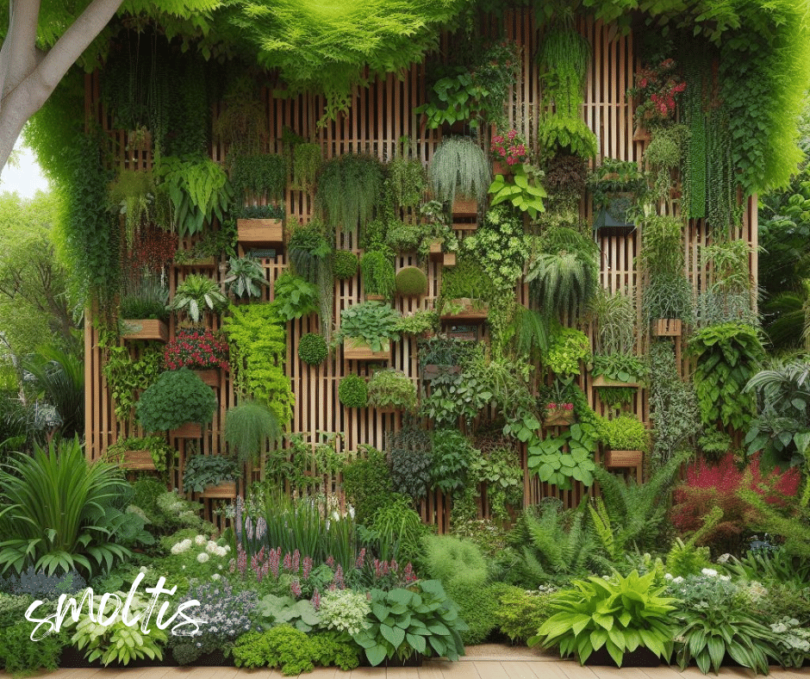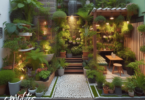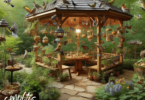Shade gardens can sometimes present a challenge when it comes to adding visual interest and depth. However, by incorporating climbing plants, you can transform your shaded space into a lush and vibrant oasis. These vertical solutions not only maximize the available space but also create a captivating visual display.

In this article, we will explore the world of shade garden design and reveal the best plants for shady areas. We will discuss the benefits of utilizing climbing plants and provide practical tips for creating a visually appealing shade garden. Whether you have a small balcony or a sprawling backyard, there are numerous options to enhance your shaded landscape.
Key Takeaways:
- Shade gardens can be enhanced by incorporating climbing plants.
- Vertical solutions maximize space in shaded areas.
- Choosing the right plants is key to a successful shade garden.
- Design techniques can create a visually appealing shade garden.
- Climbing plants and shrubs are alternative options for shade gardens.
Understanding Shade Gardens: A Primer
Shade gardens provide a unique opportunity to create lush, green sanctuaries even in the absence of direct sunlight. These gardens are characterized by areas that receive limited or filtered light, making it essential to choose the right plants that can thrive in such conditions. By understanding the specific requirements of shade garden plants and selecting the best species for shady areas, you can transform your shaded space into a vibrant and enchanting oasis.
When it comes to shade garden plants, selecting the right species is key. Look for plants that are adapted to low light conditions and are known for their shade tolerance. Some of the best plants for shady areas include ferns, hostas, heucheras, astilbes, and pulmonarias. These plants not only tolerate shade but also add texture, color, and interest to the garden.
“Shade gardens provide a unique opportunity to create lush, green sanctuaries even in the absence of direct sunlight.”
To ensure a successful shade garden, consider factors such as soil type, moisture levels, and the amount of shade the area receives. Some plants perform best in dappled shade, while others thrive in deep shade. By carefully assessing these conditions and selecting plants that match these requirements, you can create a harmonious and thriving shade garden.
Choosing the Right Shade Garden Plants
When selecting plants for shady areas, it’s important to consider their preferred light levels. Some shade-loving plants, like ferns and hostas, can tolerate a range of light conditions, while others, like pulmonarias, require more shade to thrive. By understanding the specific light preferences of plants, you can create a well-balanced and visually appealing shade garden.
- Consider the overall design of your shade garden and select plants that complement each other in terms of height, foliage texture, and flower color.
- Pay attention to the growth habits of shade garden plants. Some plants, like heucheras, have mounding habits, while others, like climbing hydrangeas, have a climbing or trailing growth habit that can add vertical interest to your garden.
- Choose plants with foliage colors that create contrast and visual interest. For example, pairing bright green ferns with dark purple heucheras can create a striking color combination.
By carefully considering these factors and selecting the right shade garden plants, you can create a beautiful and thriving shaded space that brings joy and tranquility to your outdoor living area.
Harnessing Vertical Space with Climbing Plants
When it comes to shade garden design, thinking vertically can transform a gloomy space into a lush oasis. Incorporating climbing plants not only adds visual interest and variety to your garden but also maximizes the use of available space. The vertical dimension offers new opportunities to introduce shade-loving plants and create captivating designs that defy convention.
One of the key advantages of utilizing climbing plants in shade gardens is their ability to cover walls, fences, and trellises, effectively softening hard surfaces and adding a touch of enchantment. These plants can effortlessly create an intimate and secluded ambiance, offering sheltered areas for relaxation and reflection.
By embracing climbers, you can transform a dull, shady corner into a vibrant tapestry of foliage. These plants can enhance the overall aesthetics of your garden by introducing height and depth, ultimately creating a dynamic and layered composition.
When it comes to incorporating climbing plants, there are countless shade plant ideas to explore. You can opt for vigorous climbers like Clematis or Hops to cover larger spaces, or choose delicate vines such as Virginia Creeper or European Ivy to add a touch of elegance to smaller areas. Each plant brings its own unique charm and character, allowing you to sculpt your shade garden according to your personal taste and style.
Design Techniques and Ideas
Here are some design techniques and creative ideas for incorporating climbers in shaded spaces:
- Create a living wall: Use a lattice or wire trellis to cover a wall with a diverse selection of climbing plants. This vertical garden will add texture and color, transforming a dull backdrop into a stunning display of foliage.
- Introduce a focal point: Install an arbor or pergola to provide a vertical structure and a captivating entrance to your shade garden. Allow climbing plants to envelop the structure, creating a sense of enchantment and a natural, airy canopy.
- Combine climbers with other shade-loving plants: Pair climbers with shade-tolerant perennials, ferns, or groundcovers to create a multi-layered planting scheme that thrives in low light conditions. This will add depth and complexity to your shade garden design.
- Play with color and texture: Choose climbing plants with different leaf shapes, colors, and textures to create contrast and visual interest. Opt for variegated foliage, vibrant blooms, or even plants with distinctive bark patterns to make your shade garden truly captivating.
- Experiment with container gardening: If you have limited ground space, consider growing climbers in containers. This allows you to create vertical features like plant towers or hanging baskets, adding a vertical element to your design.
By harnessing vertical space with climbing plants, you can transform your shade garden into a captivating and breathtaking sanctuary. From covering walls to creating stunning focal points, the possibilities are endless. The key is to select the right shade-loving plants that thrive in your specific conditions and incorporate them thoughtfully into your overall shade garden design.
Top Climbing Plants for Shade Gardens
If you’re looking to add vertical interest and lushness to your shade garden, incorporating climbing plants can be a game-changer. These versatile plants not only beautify your space but also make the most of limited sunlight. Here, we’ve curated a list of the best climbers that thrive in shade gardens. Let’s take a closer look:
1. Boston Ivy (Parthenocissus tricuspidata)
A favorite among shade garden enthusiasts, Boston Ivy is known for its vibrant foliage that turns a stunning shade of red in the fall. This fast-growing climber is low-maintenance and prefers partial to full shade. It attaches itself to walls or trellises, creating a beautiful living curtain.
2. Carolina Jessamine (Gelsemium sempervirens)
Carolina Jessamine is a twining vine native to the southeastern United States. With its yellow, trumpet-shaped flowers, it adds a touch of elegance to any shade garden. This evergreen climber prefers partial shade and thrives in moist, well-draining soil.
3. Climbing Hydrangea (Hydrangea anomala subsp. petiolaris)
If you’re looking for a climbing plant with show-stopping blooms, Climbing Hydrangea is a perfect choice. This deciduous vine produces clusters of white, fragrant flowers in the summer. It prefers partial shade and requires sturdy support as it can reach heights of up to 50 feet.
4. Trumpet Vine (Campsis radicans)
Trumpet Vine is a vigorous climber that thrives in a variety of light conditions, including partial shade. It features vibrant, trumpet-shaped flowers in shades of red, orange, and yellow. This low-maintenance vine attracts hummingbirds and butterflies, adding life to your shade garden.
5. Sweet Autumn Clematis (Clematis terniflora)
Known for its profusion of fragrant white flowers, Sweet Autumn Clematis is a reliable climber for shady areas. This vigorous vine blooms from late summer to early fall and prefers partial shade. It pairs well with other shade-loving plants, creating a stunning floral display.
These climbing plants are just a few examples of the many options available for shade gardens. Before planting, ensure that you provide proper support and consider the individual light requirements of each species. With the right selection, you can transform your shade garden into a vertical paradise.
Shrubs for Shade Gardens: An Alternative Solution
While climbing plants are often the go-to choice for adding vertical interest to shade gardens, shrubs can offer a compelling alternative. With their compact growth habits and ability to thrive in shaded conditions, these versatile plants can have a significant impact on the overall design and aesthetic of a shaded space.
One of the advantages of using shrubs in shade gardens is their ability to create a sense of structure and permanence. Unlike vines that rely on trellises or supports, shrubs can stand on their own, providing a solid backdrop or focal point within the garden. Additionally, many shrubs offer attractive foliage and flowers, adding color and texture to shady areas.
When selecting shrubs for shade gardens, it is essential to choose varieties that have adapted to low light conditions. Some popular options include:
Rhododendrons
Known for their stunning flowers, rhododendrons thrive in shady environments. These evergreen shrubs come in a variety of colors and sizes, making them a versatile choice for shade gardens.
Azaleas
Similar to rhododendrons, azaleas are prized for their vibrant blooms. These deciduous or evergreen shrubs are available in a range of colors, providing a burst of color to shady areas.
Ferns
Ferns are an excellent choice for adding lush greenery to shade gardens. These perennial plants thrive in moist, shady conditions and come in various shapes and sizes, offering a natural and graceful aesthetic.
By strategically placing shrubs throughout a shade garden, it is possible to create natural divisions or visual interest. Grouping different varieties together can add depth and dimension, while incorporating contrasting textures and foliage colors can enhance the overall appeal.
Overall, while climbing plants remain a popular choice for vertical solutions in shaded areas, shrubs can offer a unique and visually appealing alternative. Their ability to provide structure, color, and texture make them a valuable addition to any shade garden design.
| Shrub Variety | Light Requirements | Growth Habits | Notable Characteristics |
|---|---|---|---|
| Rhododendrons | Partial to full shade | Evergreen or deciduous | Stunning flowers in various colors |
| Azaleas | Partial shade to full shade | Evergreen or deciduous | Colorful blooms in a wide range of shades |
| Ferns | Shade to partial shade | Non-flowering | Lush, feathery foliage in various shades of green |
Design Tips for Creating a Lush Shade Garden
Designing a lush shade garden requires careful consideration of various elements to create a visually appealing and harmonious space. By implementing the right design strategies, you can transform your shaded areas into vibrant, thriving oases. Here are some practical tips and techniques to help you design the perfect shade garden.
1. Choose a Harmonious Color Palette
When selecting plants for your shade garden, opt for a color palette that complements the natural surroundings and evokes a sense of tranquility. Shades of cool blues, purples, and greens can create a soothing atmosphere, while pops of vibrant pinks, oranges, and yellows can add visual interest and contrast.
2. Layer Plants for Depth and Texture
To create a lush and dynamic shade garden, incorporate plants with varying heights, shapes, and textures. Layer taller plants in the back to provide a backdrop and add depth to the space. Place medium-sized plants in the middle, and use low-growing groundcovers or spreading perennials at the front to fill gaps and create a carpet-like effect.
3. Utilize Focal Points
Introduce focal points in your shade garden to draw the eye and create visual interest. This can be achieved through the use of architectural elements, such as trellises, arbors, or sculptures. Additionally, a well-placed bench or seating area can serve as a focal point and provide a spot for relaxation and contemplation amidst the lush foliage.
4. Incorporate Shade-Loving Plant Varieties
When choosing plants for your shade garden, consider shade-loving varieties that thrive in low light conditions. Some popular options include:
| Plant | Description |
|---|---|
| Hosta | A versatile perennial known for its attractive foliage and tolerance to shade. |
| Ferns | Delicate and graceful, ferns add a touch of elegance to shady areas. |
| Astilbe | Produces plumes of feathery flowers in shades of pink, red, and white. |
| Bleeding Heart | A charming plant with heart-shaped flowers that bloom in spring. |
5. Create Pathways and Tranquil Spaces
Integrate meandering pathways or stepping stones into your shade garden design to create a sense of exploration and invite visitors to immerse themselves in the lush surroundings. Additionally, incorporate small seating areas or quiet corners for relaxation, reflection, and the enjoyment of nature.
6. Maintain Proper Plant Care
Ensuring the health and vitality of your shade garden requires proper plant care. Regularly prune and trim plants to maintain their shape and promote healthy growth. Keep the soil well-drained and amend it with organic matter to enhance fertility. Additionally, monitor moisture levels and provide adequate watering to keep your shade garden thriving.
By incorporating these design tips into your shade garden, you can create a lush and inviting space that showcases the beauty of shade-loving plants and provides a tranquil retreat within your outdoor environment.
Conclusion
Incorporating climbing plants and shrubs in shade gardens is a key strategy for transforming these low-light spaces into lush and visually stunning havens. Throughout this article, we have explored the benefits and possibilities of utilizing vertical solutions to maximize the potential of shade gardens.
By understanding the characteristics of shade gardens and selecting the right plants for these conditions, gardeners can create thriving and vibrant spaces. Climbing plants offer the opportunity to take advantage of vertical space, adding texture, depth, and interest to shaded areas.
Additionally, shrubs provide an alternative solution for shade gardens, bringing structure and form to the landscape. With careful selection and design, these plants can create beautiful focal points and create a sense of enclosure in shaded areas.
As you embark on your shade garden journey, we encourage you to experiment with different climbing plants and shrubs, considering their unique qualities and needs. With proper care and attention, your shade garden can become a captivating retreat, showcasing the beauty and versatility of these wonderful plants.
FAQ
Can I grow climbing plants in shade gardens?
Yes, you can incorporate climbing plants in shade gardens. While most climbing plants prefer full sunlight, there are several varieties that thrive in low light conditions. By selecting the right types of climbers and providing the necessary support structures, you can create stunning vertical solutions in shaded areas.
What are the best plants for shady areas?
Some of the best plants for shady areas include ferns, hostas, astilbes, bleeding hearts, and heucheras. These plants are known for their ability to handle low light conditions and add beauty to shady gardens. Additionally, there are specific shade-loving varieties of flowering plants, such as impatiens and begonias, that can bring vibrant colors to shaded spaces.
How can I incorporate climbing plants in shade garden designs?
To incorporate climbing plants in shade garden designs, consider using trellises, arbors, or pergolas to provide adequate support. Choose shade-tolerant climbers such as clematis, climbing hydrangeas, or jasmine. These climbers can add visual interest and vertical layers to your shaded garden, creating a dynamic and lush environment.
What are some popular climbing plants for shade gardens?
Some popular climbing plants for shade gardens include Virginia creeper, English ivy, climbing hydrangeas, and sweet autumn clematis. These plants are known for their ability to thrive in partially shaded or shaded areas. They offer attractive foliage, beautiful flowers, and even vibrant fall colors, making them ideal choices for adding height and texture to shade gardens.
Can I use shrubs in shade gardens instead of climbing plants?
Absolutely! Shrubs can be an excellent alternative to climbing plants in shade gardens. Some suitable shrubs for shade include azaleas, rhododendrons, boxwoods, and hollies. These shrubs provide year-round greenery, beautiful blooms, and can serve as focal points or hedges, adding structure and depth to your shaded garden.
How can I create a lush shade garden design?
To create a lush shade garden design, consider layering plants of different heights and textures. Choose shade-tolerant plants with varying leaf shapes and colors to create visual interest. Additionally, incorporating elements like stones, water features, and ornamental structures can enhance the overall aesthetic appeal of your shade garden.







